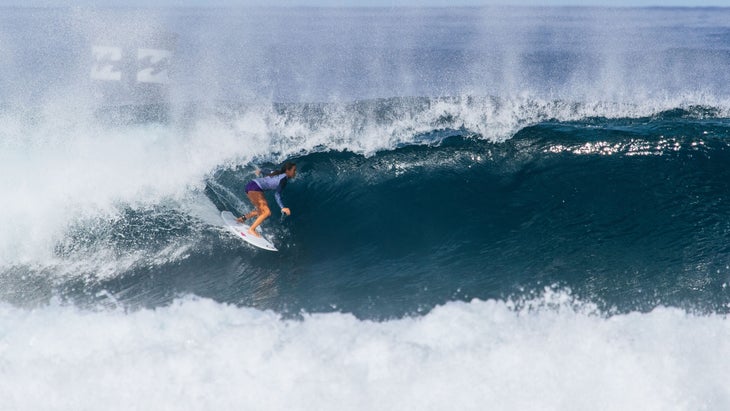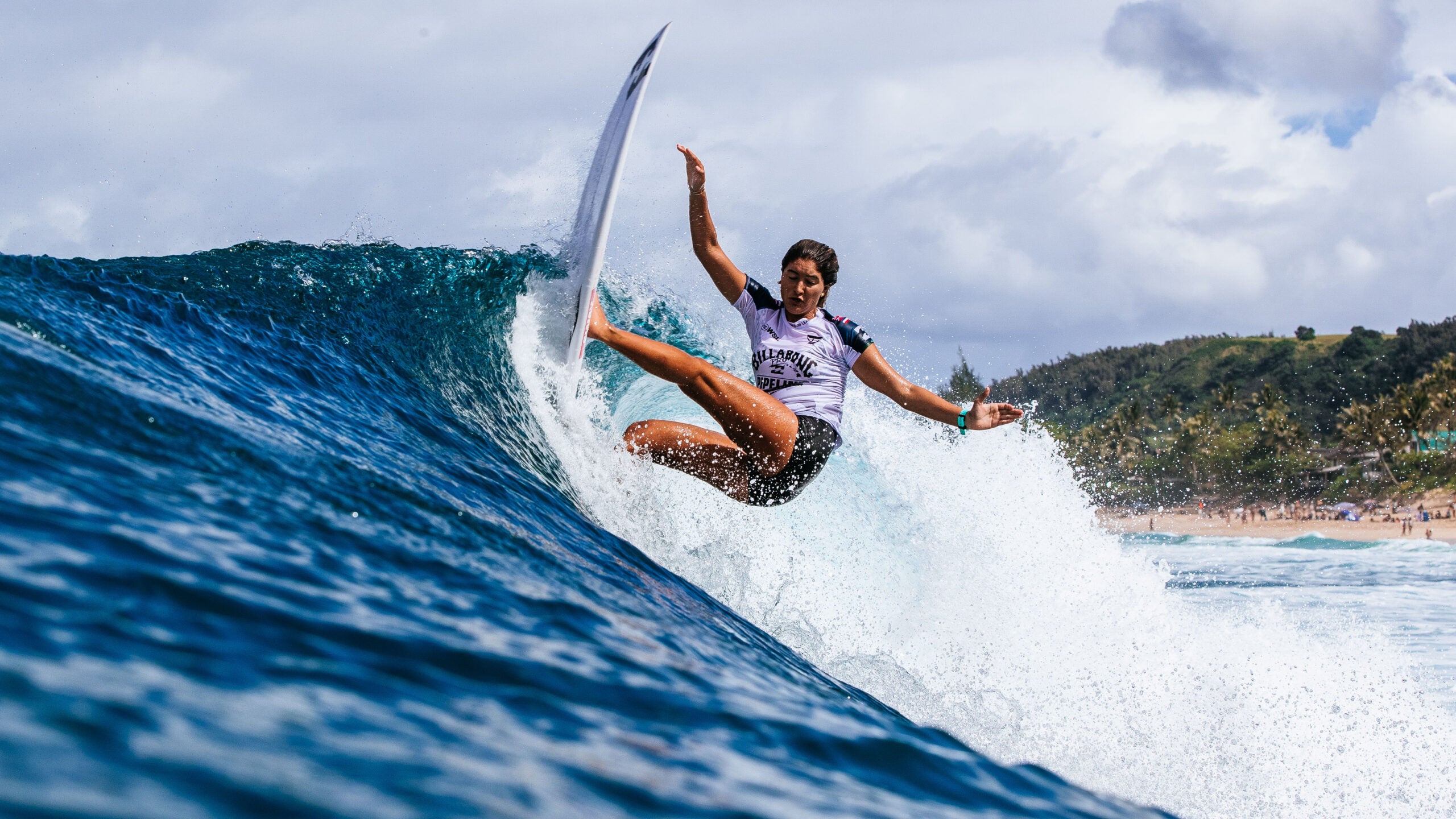When Hawaiian pro surfer Moana Jones Wong paddles for a wave at famed break Banzai Pipeline on Oahu’s North Shore, her heart races. At the takeoff point, the wave pitches up steeply, anywhere from six to 20 feet above the shallow reef. Wong knows that any mistake will almost certainly send her into what lies below.
Dropping from the sky, Wong slices her board’s rail into the wave’s face and sets her line. When all goes well, she passes unscathed through Pipeline’s magic tunnel and speeds out the other side in a torrent of spray.
“When you get barreled out there, it’s just the best feeling ever,” Wong says. “The wave has this hold on me and there’s nothing better than surfing Pipe and getting a sick barrel.”
One of the most beautiful and deadly waves in the world, Pipeline has fired the imaginations of surfers for generations. Every winter the world’s best surfers converge on the lineup to test their courage and try to score the barrel of their life. This week, it’s the site of history. Eighteen female professional surfers are competing in the first ever women’s Billabong Pro Pipeline, the opening event in the 2022 World Championship Tour.
The event runs January 29 through February 10.

The world’s best male surfers have competed in the Pipeline Masters event since 1971, but women have rarely had the opportunity to surf in organized events there due to a combination of funding problems, sexism, and the sport’s slow progression. Over the years multiple women have tried to speed up that process. In 1989, pro surfer “Banzai” Betty Depolito started a lower-tier contest for women at the break. The competition was originally for bodyboarders, because at the time there were not enough women surfing Pipeline, Depolito says.
After six seasons Depolito added a surfing competition, but she could never obtain permits from the local government to hold her event during the peak winter season, when the waves are biggest.
“The guys around here have not been very supportive,” Depolito says. “They freak out if they lose a contest or they feel like something’s being taken away from them. It’s mainly because they think they’re so much better and they’re men and they have to feed their families. But we have to pay our mortgages too.”
Few women ventured into the wave’s hypercompetitive lineup back then. Retired pro Rochelle Ballard, 50, a Pipeline pioneer, tried to convince her peers to paddle out and found few takers. Ballard and fellow pro Keala Kennelly surfed the wave alongside a horde of men.
“I didn’t think it was going to happen until now, because it’s like, ‘You guys have to go surf it, or it’s never going to happen,’” Ballard says. “It wasn’t ever about me. It wasn’t ever about Keala—it had to be a bigger group of women at the time and the age that a Pipeline contest came.”
During the winter months, storms spin up in the North Pacific and form swells that, after traveling through the deep waters of the open ocean, explode on the shallow reef at Pipeline. The contours of the reef give the wave its famous cylindrical shape. Sitting in the lineup, a surfer can go left or right, depending on the swell direction, her skill level, and her inclination. The right is known as Backdoor, while the left is Pipeline proper. The wave’s power, the shallow water over the reef, the steep takeoff, the way the peak shifts with the tide and swell direction, all add up to the danger and difficulty of surfing Pipeline.
“It’s such a vertical drop, the way the wave jacks up right where you have to take off. That alone is just really intimidating,” says Kennelly, 43, who started surfing Pipeline in the 1990s. “And then it breaks on gnarly shallow reef.”
A good swell draws some of the world’s best surfers, as well as the most dedicated locals on the planet, and the lineup can be more competitive during a freesurfing session than it is during a contest heat. Women can often find themselves at a disadvantage in the predominantly male lineup.
Wong has sometimes spent six hours in the water at Pipeline to ride a single wave. Some days, she won’t get a wave at all.
“You can feel the vibe out there,” Wong says. “Everyone’s aggressive, everyone’s anxious, everyone’s stressing a little bit. It’s not calm and relaxed at all.”
The absence of a top-level contest for women has meant little incentive for pro surfers to paddle out at Pipeline. Instead, women have pushed boundaries on other waves. Carissa Moore, the reigning Olympic champion, recently landed one of the biggest airs ever in a women’s contest heat at Australia’s Rip Curl Newcastle Cup. But Moore has had little reason to risk it all out at Pipeline until now.
The addition of a women’s Championship Tour event at Pipeline continues a steady progression toward greater equity in pro surfing. In 2019 the World Surf League—the governing body for pro surfers—began paying women equal prize money. A woman winning a single event on the Championship Tour in 2019 won more in prize money than seven-time world champion Stephanie Gilmore earned for her first title in 2007.
Another improvement has been the WSL’s move to hold women’s events when the waves are at their peak. In previous years it was common to see organizers run the women’s heats in smaller conditions. These days women often surf the same day as the men.
That wasn’t the case for the opening weekend at the Pipeline Pro, however. On Saturday, January 29, the men kicked off the competition in thumping ten- to 12-foot waves. Rather than send the women’s heats out into the surf, the WSL waited until Sunday. The inaugural women’s heats took place in noticeably smaller conditions.
Jessi Miley-Dyer, the WSL’s head of competition, said she made the call to delay the women’s heats.
“Pipeline is the most competitive and challenging lineup in the world, and for many of the women on the Championship Tour, Sunday was their first time out in the lineup on their own,” Miley-Dyer says. “It was important to me that we had a day in manageable conditions to allow everyone the opportunity to get a feel for being out in the lineup and experience the wave.”
Miley-Dyer said the competition would seek out bigger conditions for the women’s later rounds. On Tuesday the swell surged to an even greater size, but the WSL again held heats for only the men.
In a post-heat interview, Wong said she’d have preferred to surf the same conditions as the men, but in their social media posts, most of her competitors seemed happy to make it through the opening day. “First heat of the first event of the season is always a little nerve-wracking, and a little extra today figuring out the Pipe lineup with only two women out,” Moore wrote on Instagram.
The first day saw top surfers Courtney Conlogue and Caroline Marks eliminated. Competition is likely to return later this week, with 16 women competing in a single-elimination format.
Moore, a five-time world champion, is a heavy favorite to win. But she says victory at Pipeline is hardly guaranteed.
“I’m not going to lie, I’m a little nervous,” she said in December. “Those kinds of waves are a little out of my comfort zone.”
While Moore may still feel nervous at the thought of paddling out at Pipeline, video of her surfing the wave in January showed her looking comfortable in the barrel. Moore is also among the few women in the contest who can go either left or right. That’s because learning to ride Pipeline backside—with the surfer’s back to the wave—adds another level of mastery.
“She surfs Pipe amazingly,” Kennelly says. “She’s always like, ‘I’m so intimidated,’ and then she goes out and kills it.”
Brazilian Tatiana West, who grew up in Kauai and is currently ranked number two in the world rankings, is another hard-charging surfer who could challenge Moore for the win.
And then there is Wong, who as a wild card may lack the world titles but has the expertise to go far. Now 23, she’s been surfing Pipeline consistently for the past five years, putting in her hours and learning the intricacies of the wave. She’s become a specialist out there and is widely considered to be the best woman yet to surf Pipeline.
Ballard, who keeps close tabs women’s surfing, compares Wong’s style to that of Pipeline legend Gerry Lopez.
“Moana is the first woman that I’ve seen who really understands how to set her line and her rail and stay in the pocket, drive through the barrel and come out,” Ballard says. “And she picks the right waves, that are the same waves that Gerry Lopez was picking. She’s really the one.”

